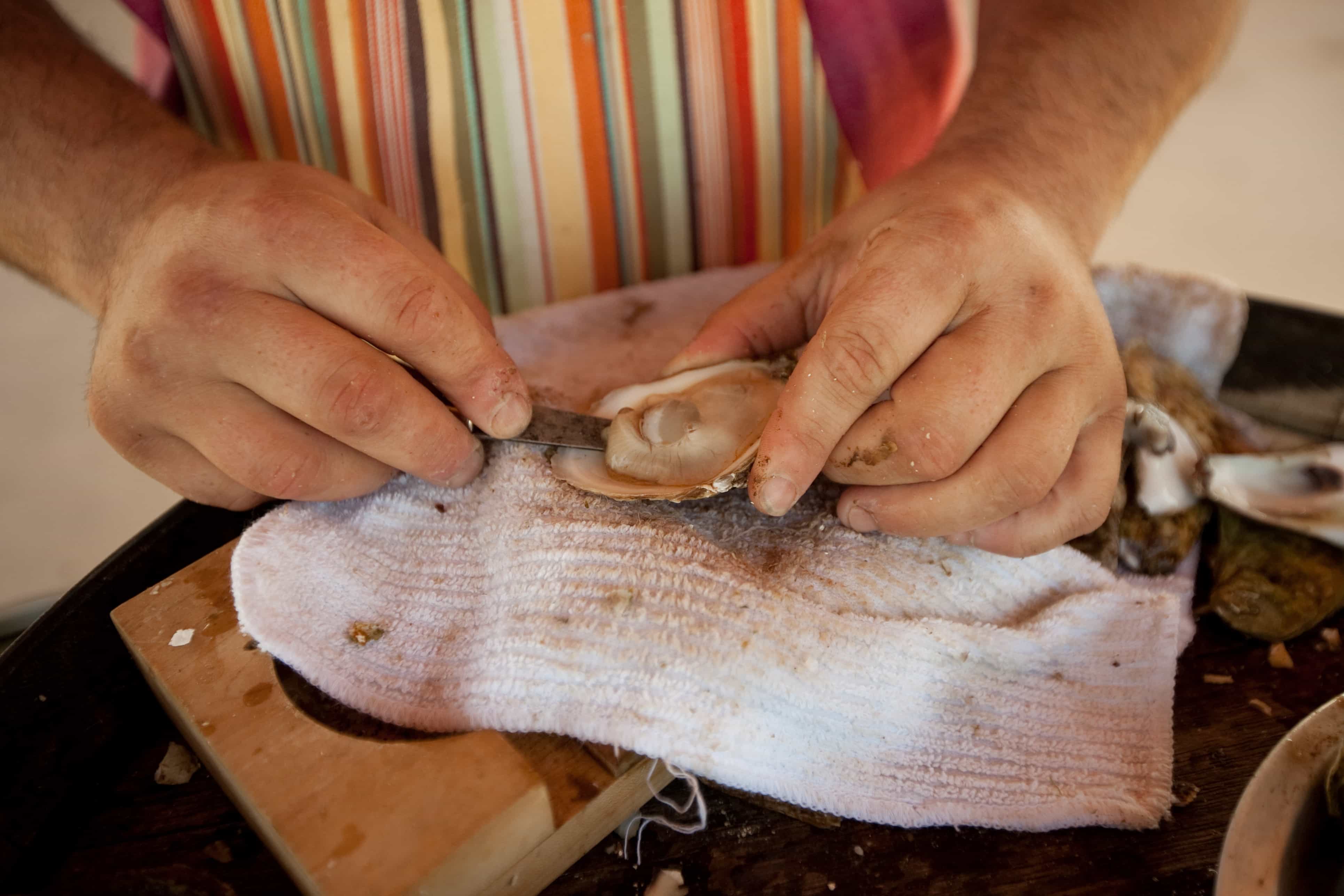
I love oysters. Oh GOODNESS, how I love oysters! My squeamish friends who have yet to drink the saline Kool-Aid and join me in bi-valve love will ask what on earth it is I like about them and the answer is EVERYTHING — the look of them, the way they smell of the sea (“that’s not necessarily a good thing” said my friend Shona) and most especially the taste of them.
I wasn’t always this way, of course. For years I refused to try the delicious things, even when my husband would gleefully enjoy oysters at restaurants or events. And then at a summer event at Hidden Bench a few years back, I was standing in the cool, dim light beside a massive riesling tank, watching everyone fervently enjoy freshly shucked oysters and I finally gave in and tried a Malpeque.
What a revelation! As the delicate flavours exploded (you wouldn’t think that “delicate” flavours could “explode” but I’m telling you, THEY DID) across my palate, I realized I was hooked. One humble oyster changed my world.
Describing oysters is akin to describing wine. Like wine (and unlike foods that require greater mastication), the pleasure of an oyster in your mouth is fleeting and complex, requiring your full concentration to discern the various flavours. Begin with the scent — a platter of shucked-in-front-of-you oysters is the freshest food imaginable, smelling deliciously and mouth-wateringly of cold sea air, immediately stimulating to the appetite. As you bring the shell to your lips, in the nanosecond before the slurp, that clean fresh scent fills your mouth and prepares it for the silky, plump mouthful to follow. Eaten on its own, or perhaps with the tiniest drop of fresh lemon, an oyster will present a heady mix of clean salt and subtle sweet, followed by minerals, fruit and metals.
Like wine, oysters have their appellations, and bivalves from different regions will display different taste profiles. In addition to the different characteristics of the five species generally available to oyster bars in North America, the intricacies of an oyster’s flavour reflect the waters in which they are grown — merroir instead of terroir, if you will. The same species of oyster, for example the Crassostrea virginica or Atlantic oyster, will taste different depending on the balance of fresh and salt water in its region.
Malpeques from PEI, Wellfleets from Cape Cod and Blue Points from New York, for example, are all virginicas but all display flavour characteristics representative of the waters where they grew up. Oysters will also taste and feel different depending on their species — a prized West coast Kumamoto oyster’s musky sweetness reflects the species as well as the waters from which it was harvested.
While oysters on the half-shell are (to me at least) the food of the gods, as a recent convert I understand that the thought of slurping down a raw sea creature puts some people off. You can cook oysters a number of ways but I believe that, in deference to the complex flavours of this simple creature, the simplest quick frying is the best. The simple preparation used in the following recipe for Oyster Po’Boy sandwiches adds a bit of dry texture and a tiny bit of seasoning, but still lets the sweet, musky shellfish flavour shine through.
So, if you’re not quite ready to belly up to shucker’s station, then sharing a lunch of these sandwiches and a glass of crisp white wine such as The Good Earth’s 2010 Dry Riesling with your favourite person is an excellent introduction to the wonderful world of oysters.
PAN-FRIED OYSTER PO’ BOYS (FULLY DRESSED)
A Saturday lunch for two
OYSTERS
6 medium or 8 small shucked oysters
3/4 cup fine corn flour (175 mL)
pinch salt
1/2 tsp Old Bay seasoning (2 mL)
1 egg, beaten with 1 teaspoon water (4 mL)
2 TBsp canola oil (30 mL)
lemon wedge
SANDWICH
French bread/baguette
Tomato, sliced
Iceberg lettuce, shredded
Pickle, sliced
Butter
Mayonnaise
ASSEMBLE your sandwich makings. SLICE baguette lengthwise into two 6-inch sections, split each piece open and butter lightly. TOAST lightly under the broiler. SPREAD mayonnaise on bread, stuff with lettuce, tomatoes and pickle slices. Set aside while you PREPARE the oysters.
DRAIN the oysters and dry them with a sheet or two of paper towel. Dredge them through the flour and shake off excess. DIP in egg mixture, shake off excess and then DREDGE in flour a second time. Heat oil in frying pan until hot (but not smoking), shake off excess flour on each oyster and place in oil, making sure you don’t crowd them. FRY oysters until golden brown on one side, then turn gently with tongs to brown the other side (approximately 3 minutes per side). REMOVE from pan and drain on paper towel for a moment. SQUEEZE lemon wedge lightly over hot oysters. STUFF each sandwich with 3 or 4 oysters, POUR two glasses of cold, crisp 2010 Dry Riesling and enjoy!
OPENING AN OYSTER
Having eaten oysters shucked by amateurs (spending hours after wondering if I was bleeding internally from all the shell fragments), I believe that shucking is an art that requires skill and practice. For the home cook, this may not always be possible so if you’re going to fry oysters, save yourself the trouble and use heat to open. Fill a large pot with about 2 inches of water and heat. Place oysters, cup side down, in a colander over the water (but not in the water) cover and steam for about 7 minutes. The shells will pop open and you can then easily open them all the way and scoop the oyster out and into a bowl. Discard any oysters that do not open.
A modified version of this post was originally published in VINES Magazine.
